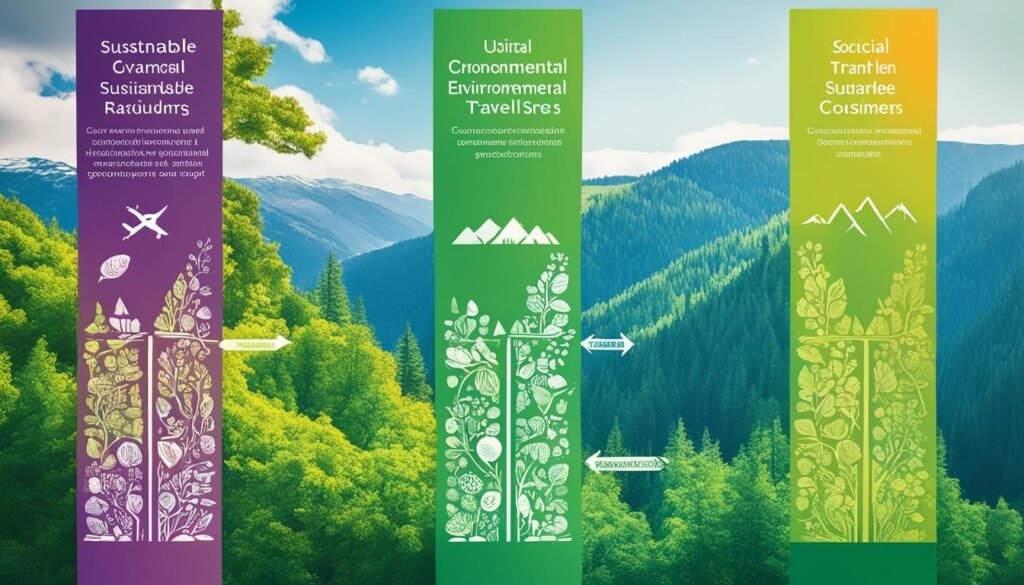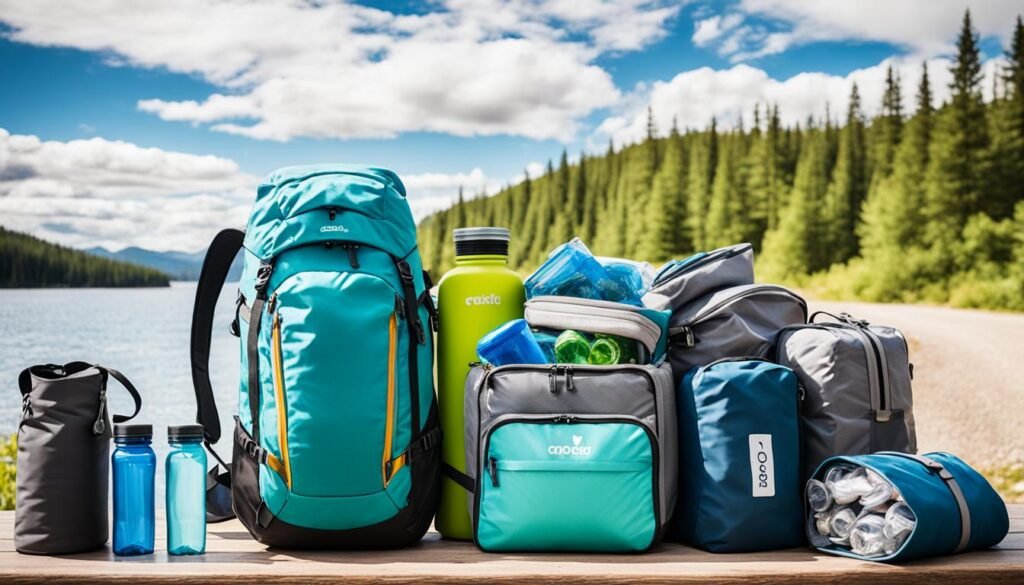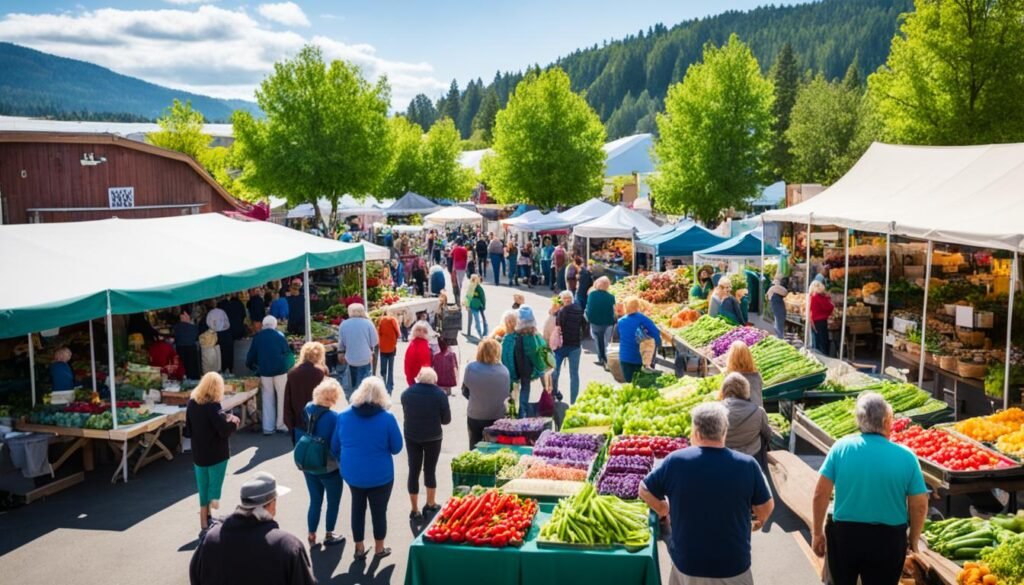The tourism industry is growing fast. So, it’s key to travel in a sustainable way. This helps reduce our carbon footprint. It’s also about being respectful towards nature and local folks. Making good choices can positively impact the places we visit.
This guide is your go-to for eco-friendly travel spots. I’ll share tips that let you enjoy trips fully while doing less harm. You’ll learn how to explore Costa Rica’s rainforests, admire Iceland’s unique spots, or find treasures in Bhutan. This article will make you a better, eco-conscious traveler.
Key Takeaways
- Sustainable travel is a rapidly growing movement in the tourism industry, with a focus on reducing environmental impact and supporting local communities.
- Eco-friendly destinations like Costa Rica, Iceland, and Bhutan offer unique opportunities to explore nature and culture while prioritizing sustainability.
- Reducing your carbon footprint, minimizing plastic use, and supporting local businesses are crucial elements of sustainable travel.
- Responsible transportation choices, such as using public transit or selecting more efficient aircraft, can significantly contribute to a greener vacation.
- Staying at eco-certified accommodations and dining at local, sustainable restaurants can enhance the overall travel experience while benefiting the local community.
What is Sustainable Travel?
Sustainable travel is a way to see the world that cares about the planet and its people. It aims to leave no lasting harm on nature. It also works to help the locals and future generations thrive.
The Importance of Sustainable Tourism
Sustainable tourism protects the earth and helps fight climate change. It also gives power and benefits to local communities. Studies show that many American travelers are ready to choose sustainable travel. But, not everyone really understands what this means. This shows the importance of teaching people about eco-friendly travel.
Defining Sustainable Travel
Sustainable travel is all about making destinations better when we leave. Over half of those who know about it see its good impact on local places. It covers things like protecting nature, fighting climate change, and helping local economies with fair and good practices.
“Sustainable travel is built upon three main pillars: environmental sustainability, social sustainability, and economic sustainability.”
The Three Pillars of Sustainability
Sustainable travel looks at three main areas: the environment, how we interact with people, and the economy. These areas work together for a good travel experience. Travel becomes better for both the visitor and the places they go to.
Environmental Pillar
This pillar looks at how travel impacts nature. It includes steps like reducing pollution, using materials that can be reused, and protecting wildlife. Staying and moving around in ways that do less harm are key.
Social Pillar
The social pillar is about building good relationships between travelers and locals. It means helping local shops, joining in community work, and not supporting harmful practices. The aim is for both visitors and hosts to gain from the experience, which adds to the local community’s wellbeing.
Economic Pillar
The last pillar wants travel to bring money and jobs to the places people visit. This happens by spending at local shops and making sure tourism work pays fairly. It’s about making sure travel helps everyone in the long run.
Sustainable travel is more than just reducing harm to nature. It links everything together across these three pillars. When travelers support the environment, people, and the economy, it makes their trips more caring and impactful.
| Pillar | Key Aspects |
|---|---|
| Environmental |
|
| Social |
|
| Economic |
|
When travelers take care of the environment, society, and the economy, their trips are more meaningful. It makes a positive difference in the places they visit.

“Sustainable tourism seeks to address current and future economic, social and environmental impacts, addressing the needs of visitors, the industry, the environment and host communities.”
– World Tourism Organization (UNWTO)
Planning Your Eco-Conscious Journey
Heading out on an eco-friendly journey takes thinking and finding the right places. We want to pick places that care for the earth and the people living there. This way, we can help the planet by traveling smart and supporting local folks.
Research and Destination Selection
Start by looking into places that are big on helping the environment. Check out spots that are serious about going green, saving wildlife, and helping the nearby people. For instance, think about Costa Rica, Iceland, and New Zealand.
Think about what the locals feel about tourists and if they are doing green things too. Also, look for places to stay and things to do that have eco-friendly labels. Doing this means you’re choosing a trip that’s good for the planet.
Responsible Travel Timing
When you travel matters for the planet and the people in the place you visit. Picking times when it’s not too busy helps protect nature and resources. This way, you get a more real taste of the place and its culture.
It’s also key to respect the local way of life when planning your visit. Adjusting your trip times to fit their cultural or environmental needs is a plus. It helps make your trip better for everyone.
Let’s keep in mind that planning right, choosing places carefully, and the timing of our visit all matter a lot. We can cut down on harm and help keep the places we love beautiful long term.
Eco-friendly Transportation
Sustainable travel is about more than just the place you go. It includes how you get there. Transportation plays a big part in the problem of too much carbon in the air. This harm mostly comes from planes. Being mindful of how we travel is key in cutting down on harmful emissions and fighting climate change.
Minimizing Carbon Footprint
Choosing airlines and transport services that care about the environment can lower our carbon footprint. Whenever possible, pick trains over planes. Also use public transport, walk, or bike at your stop. Travel providers might offer ways to offset the emissions from your flights.
Sustainable Transportation Options
- Trains: Trains are better for the planet than planes because they release less carbon dioxide per person’s journey.
- Electric or hybrid vehicles: If you need a car, choose an electric or hybrid one to cut down on pollution.
- Bicycles and pedestrian travel: Walking or biking around is not only eco-friendly but a great way to experience local life.
- Public transportation: Buses and trains in a city also help you lower your carbon impact and support green building.
| Transportation Mode | CO2 Emissions per Passenger-Mile |
|---|---|
| Airplane | 0.41 kg CO2 |
| Car | 0.26 kg CO2 |
| Train | 0.12 kg CO2 |
| Bus | 0.10 kg CO2 |
Choosing green ways to travel can make a big difference. It helps lower our carbon output and makes the future of travel better for all.

Eco-friendly Destination Guides for Sustainable Travel
The travel industry causes about 8% of the world’s greenhouse gas emissions. This is why more people are looking for eco-friendly ways to travel. This kind of travel focuses on limiting pollution and caring for nature. It also means eating in ways that are good for the Earth and helping local people. With more folks wanting green travel options, guides that show ethical places to visit have become very important.
These guides share tips for seeing the world in a green way. They point out places truly dedicated to being earth-friendly. They help you find places to stay that care for the environment. They also show how you can move around without causing a lot of pollution. And they highlight local shops and places to eat that are eco-friendly. This allows travelers to choose options that are good for the planet and local communities.
Planning a trip that’s good for the Earth is easier with these guides. They help you pick places that care about nature and people. They might suggest when it’s best to visit to not stress out the local area. With these guides, you learn how to travel in ways that aren’t harmful. They show why it’s important to be mindful of our choices when exploring and the benefits of doing so.
Eco-friendly guides are key for those wanting to travel the right way. They’re great for finding trips that focus on keeping nature and culture alive. And as more people want to travel without hurting the planet, these guides will be with them on every journey. They are essential for those who love to travel but also care about the Earth and its communities.
| Sustainable Travel Initiatives | Key Benefits |
|---|---|
|
|

“Sustainable travel is an ongoing practice that involves integrating responsible choices into all aspects of travel planning and execution.”
Using eco-friendly guides makes sure your travels are good for the planet. They help you pick places that really care. These guides are a tool for responsible and sustainable travel. They make sure your trip is good for the Earth and everyone you meet along the way.
Sustainable Accommodations
For those who love our planet, picking the right place to stay is key. It’s best to choose stays that are all about saving the Earth. This includes green hotels, local places, and spots that help the community. By going this route, we can travel lighter and make good tourism choices.
Eco-Certified Hotels and Resorts
When looking for a place to bunk, check for green certifications like LEED or Green Globe. By having these, places show they really are green. They use less energy, water, and make less garbage. When we stay, we help by doing simple ways to save, like using less water or not washing towels every day.
Local and Community-Based Lodging
Staying in places owned by local folks helps our planet. Often, these spots work hard not to waste, to recycle, and to avoid plastic. They might use less water and gather rain too. Picking these places lets us travel more like a local and less like a tourist. It also helps the Earth and the people who live there.
| Eco-Certified Hotels | Local and Community-Based Lodging |
|---|---|
|
|

“Choosing eco-friendly accommodations is a simple yet powerful way to reduce the environmental impact of our travels and support sustainable tourism practices.”
Responsible Dining and Entertainment
Being eco-conscious citizens, we have the power to make sustainable choices in our eating and entertainment. We should support local venues, eat food produced nearby, and pick places that care about the earth. This way, we cut down on our travel’s carbon footprint and help the community thrive.
Supporting Local Businesses
When we visit new places, choosing to eat at local spots is key for responsible dining. Local spots often get their food from close by, which lessens the trip it takes to get to your plate. Also, by eating there, you support the area’s economy and its people.
Eco-Friendly Restaurants
Seek out eateries that value green practices. These places might use energy that’s good for the earth, save water, and use less food. Some even have their own gardens or get their food from local, organic sources. Eating at these places lets you enjoy meals that do good for the environment.

The travel world creates a lot of pollution, mainly through moving people around. But, by eating wisely, we can make a good difference. This fits perfectly with sustainable tourism, which wants to do good for everyone, from the land to the people.
“Sustainable travel emphasizes minimizing negative environmental impacts and supporting local communities.”
Exploring farmer’s markets, finding hidden food spots, and choosing plant-based meals are great steps for a green journey. When we support local and earth-loving places, we get to enjoy good food that’s good for the planet. Thus, we help in making the places we visit a better, greener home for all.
Eco-Conscious Activities and Attractions
Eco-conscious travelers get a chance to enjoy unique experiences. These experiences help the places and people we visit. You can enjoy nature adventures and dive into different cultures.
Hiking is a top eco-friendly activity. It lets us explore looking The Aerial in the British Virgin Islands. This spot has vast hiking paths and lets us connect with nature. We get to see birds and wildlife, all while helping to protect these special places.
If you love the ocean, join in on activities like reef clean-ups, tagging turtles, and fishing the right way. These actions help take care of the sea. They also make us value its beauty more.
Choosing locally grown and organic meals is a great move. It supports the area’s people and the environment. Eating at green places means less harm to the earth.
Staying in green hotels that use clean energy and save water makes our stay better. These options care for the planet. They also let us get to know the folks who live there.
- Explore scenic hiking trails and birdwatching experiences that connect us with nature
- Participate in sustainable ocean activities like reef clean-ups and turtle tagging
- Savor locally sourced, organic meals at eco-friendly restaurants
- Opt for eco-friendly accommodations that prioritize renewable energy and conservation
Doing eco-friendly things and choosing sustainable places help fun travels. They also help keep natural and cultural spots safe. Our decisions as eco-travelers can have a big, positive effect on the places we go.

“Sustainable travel is not just a trend; it’s a necessity in an age of climate change and over-tourism.”
Sustainable Souvenir Shopping
Souvenir shopping can be a way to support the environment and local communities. It’s all about choosing items that are good for the planet. By focusing on sustainable options, we can help local people, encourage fair trade, and lessen our impact on nature.
Ethical and Local Souvenirs
Think about where your souvenirs come from. Choose items that are made locally or by artisans. This supports the local economy and keeps your souvenirs eco-friendly.
Go for things made from natural or recycled materials. Things like textiles, wood carvings, and repurposed glass are great. Stay away from items that harm the environment, like those made from endangered animals.
For a better shopping experience, look for fair trade labels and support community projects. This helps ensure that the people making your souvenirs are treated well and paid fairly.
| Sustainable Souvenir Options | Eco-Friendly Benefits |
|---|---|
| Handcrafted Textiles | Support local weavers and artisans, reduce waste, and showcase cultural heritage. |
| Artisanal Pottery and Ceramics | Promote local craft traditions, use sustainable materials, and eliminate plastic waste. |
| Repurposed or Recycled Accessories | Contribute to a circular economy, reduce environmental impact, and give new life to materials. |
| Organic, Fair Trade Edible Treats | Support sustainable agricultural practices, empower local producers, and provide a delicious taste of the destination. |
Choosing the right souvenirs can make a big difference. Let’s pick items that do good for us and the places we visit. This way, each purchase can benefit both us and the communities we explore.

“Sustainable travel is not just about the journey, but also the memories we take home. By choosing ethical souvenirs, we can carry a piece of the destination’s heart with us, while supporting its future.”
Reducing Waste and Recycling
As travelers who care about the earth, we should aim to lessen our impact. This means focusing on creating less trash and encouraging others to recycle.
It’s important to not use single-use plastics when we visit new places. Avoiding things like disposable water bottles and plastic bags is key. I carry a reusable water bottle and food containers with me. This cuts down on plastic use, helps the environment, and saves me money.
Throwing away trash the right way and recycling are vital. I put any trash in the right bins to be recycled or composted. This action stops more trash from filling up our landfills.
I also try to use less energy and water as I travel. Turning off lights and reusing towels are simple but effective ways to do this. It reduces my impact on the environment.
These actions help me be a sustainable traveler. They also encourage others to join in and make small changes too. Each effort adds up and makes a big difference.
| Sustainable Travel Practices | Impact |
|---|---|
| Avoiding single-use plastics | Reduces plastic waste and conserves resources |
| Proper waste disposal and recycling | Diverts materials from landfills and promotes a circular economy |
| Conserving energy and water | Decreases the environmental impact of travel |
| Carrying reusable water bottles and containers | Minimizes the use of disposable items and saves money |
By using these good practices, we can waste less and recycle more. This way, we help make zero-waste travel a reality. Let’s work together to keep our beautiful planet safe.

“The greatest threat to our planet is the belief that someone else will save it.” – Robert Swan
Supporting Local Communities
Sustainable travel is all about reducing harm and helping local communities. When we travel responsibly, we support the local economy by staying in local places, eating at family restaurants, and buying local souvenirs. This helps the communities we visit become stronger and more meaningful places.
We can back local communities by staying at hotels that care about the environment and hire locally. This choice lowers the accommodation’s impact on the environment and supports local jobs and businesses. Choosing small, local places over big chains means more money stays in the community.
Eating at local, family restaurants supports the community, too. These places keep traditions alive and can provide jobs. For a real taste of the area, look for local food markets and community culinary events.
Buying souvenirs from local artisans helps the local economy and preserves traditions. These handcrafted items are unique and support local families. By picking these items over mass-produced goods, you help keep traditions and cultures alive.

Sustainable travel has social benefits, too. By interacting with locals, joining community events, and learning about the place’s traditions, you can make meaningful connections. This sharing of cultures makes your trip more rewarding for everyone involved.
Choosing local businesses and experiences make your trip more valuable. Not only does it make your journey better, but it also supports the places you visit in the long run.
Conclusion
Sustainable travel is a crucial change in how we see the world. By picking green choices from start to finish, we can cut our impact. This guide showed us how to travel sustainably, focusing on green transport and places to stay. It also highlighted eating and shopping in ethical ways. Choosing these options helps our planet and its people.
The travel industry is bouncing back from COVID-19. The interest in eco-travel is growing. Young people, in particular, are ready to spend more on greener choices. This is pushing companies to offer earth-friendly trips. They provide green stays and less-harmful adventure trips.
However, as green travel grows, so does ‘greenwashing.’ This is when firms falsely claim to be eco-friendly. To avoid this, look for clear certifications and join responsible travel groups. This way, our travel choices can truly support the health of our planet and its communities.
FAQ
What is sustainable travel?
Why is sustainable travel important?
What are the three pillars of sustainability?
How can I plan an eco-conscious journey?
How can I minimize my carbon footprint while traveling?
Where can I find eco-friendly destination guides?
How can I find sustainable accommodations?
What are some sustainable dining and entertainment options?
How can I find eco-conscious activities and attractions?
How can I shop for sustainable souvenirs?
How can I reduce waste and promote recycling while traveling?
How can I support local communities during my travels?
Source Links
- https://www.linkedin.com/pulse/ultimate-guide-sustainable-travel-how-explore-world-chowdhury-pcgjc
- https://www.nomadicmatt.com/travel-blogs/sustainable-travel-guide/
- https://www.thetopvillas.com/blog/travel-guides/a-guide-to-sustainable-travel-destinations-and-ecotourism/
- https://www.nationalgeographic.com/travel/article/what-sustainable-tourism-means
- https://pollygoes.com/what-is-sustainable-travel/
- https://hiddenlemur.com/what-is-sustainable-travel/
- https://apiabroad.com/blog/the-three-pillars-of-sustainable-travel-environmental-economic-and-socio-cultural/
- https://jillonjourney.com/the-three-pillars-of-sustainability-in-tourism/
- https://stateofmatterapparel.com/blogs/som-blog/sustainable-travel-how-to-travel-with-the-environment-in-mind
- https://www.ecomatcher.com/how-to-travel-sustainably-a-guide-for-eco-conscious-explorers
- https://www.bambuhome.com/blogs/bambuliving/sustainable-travel-tips
- https://www.linkedin.com/pulse/how-plan-eco-friendly-vacation-10-sustainable-harun-tasci
- https://www.gourmetmarketing.net/blog/guide-to-sustainable-and-eco-friendly-travel
- https://www.lennylarry.com/blogs/news/no-trace-sustainable-travel-guide
- https://www.sevencorners.com/blog/travel-tips/easy-guide-to-traveling-sustainably
- https://explorerspassage.com/chronicles/sustainable-travel-guide/
- https://medium.com/@neeraj_90065/sustainable-travel-guide-embark-on-an-eco-friendly-journey-27868029de4e
- https://www.ecomatcher.com/how-to-travel-sustainably-a-guide-for-eco-conscious-explorers/
- https://medium.com/@jayrald.ado/sustainable-travel-a-nomads-guide-to-eco-friendly-accommodation-choices-06cf48b11a65
- https://ecopeaco.com/blogs/pod/your-6-step-guide-to-a-sustainably-conscious-family-trip
- https://blog.bambatravel.com/embark-on-an-eco-friendly-adventure-a-guide-to-sustainable-travel/
- https://sustainabletravel.org/top-10-tips-for-sustainable-travel/
- https://zonlihome.com/blogs/our-blog/sustainable-travel-eco-friendly-practices-for-responsible-explorers
- https://medium.com/stravaiging/cherish-the-world-you-wander-sustainable-travel-guide-ad60bd40100f
- https://aerialbvi.com/blog/eco-friendly-tourism-activities/
- https://forestnation.com/blog/eco-conscious-adventures-a-guide-to-sustainable-travel-in-the-andaman-and-nicobar-islands/
- https://www.circawanderlust.com/sustainable-travel-tips-2/
- https://curiositysavestravel.com/sustainable-ethical-souvenir-and-gift-guide/
- https://travelingpartyof4.com/sustainable-souvenirs/
- https://chaninvictor.com/embracing-sustainability-on-a-budget-affordable-eco-friendly-travel-options/
- https://passingthru.com/best-practices-for-sustainable-travel/
- https://www.landfillrules.com/blog/sustainable-summer-travel-how-to-reduce-waste-on-your-trips
- https://www.agood.com/blogs/stories/a-guide-to-sustainable-travel-minimise-your-carbon-footprint
- https://www.tourhq.com/article/from-supporting-local-communities-to-environmental-preservation-10-ways-to-mindful-travel
- https://www.theblondeabroad.com/ultimate-eco-travel-guide/
- https://www.weraddicted.com/earth-friendly-escapes-a-guide-to-sustainable-travel-around-the-globe/
- https://earth.org/eco-friendly-travel-exploring-sustainable-tourism/
- https://www.graygroupintl.com/blog/eco-tourism
- https://www.theearthsafari.com/tour/responsible-eco-tourism


